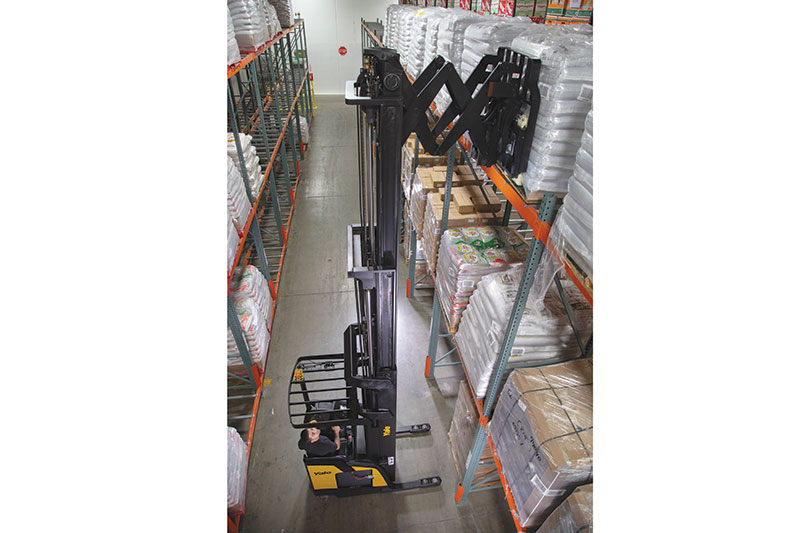Lift Truck Tips: Go narrow but keep the comfort
With narrower aisle configurations on the rise due to warehouse capacity issues, reach truck ergonomics can help when it comes to productivity and safety.
The counterbalanced forklift remains a mainstay for DC operations, well suited to many tasks and capable of lifting the heaviest loads. But when it comes to gaining space in DCs with narrow aisle rack and storage configurations, other lift truck types and designs come into their own.
While many DCs function well with standard 12-foot-wide aisles, fulfillment and DC real estate trends are driving more operations to squeeze more storage capacity out of existing buildings by going to narrow layouts, with widths in the 8- to 10-foot range.
For these layouts, reach trucks are a go-to equipment category, since they are more compact than counterbalanced trucks and have a tighter turning radius, points out Jim Hess, director of warehouse business development for Yale Materials Handling Corp.
Hess advises that DC mangers carefully consider the ergonomic features of reach trucks, as more facilities look to tighten up on rack layouts to create more capacity. He notes that the continued rapid growth of e-commerce and increased need for fulfillment capacity is driving up the cost of warehouse space, either to build or lease. Short of facility expansion, the best bet is to make better use of total cubic space of existing DCs.
“With the proliferation of SKUs that are having to be put into warehouses, companies are looking for ways to maximize the space they already have and gain more pick faces for the added SKUs growth,” says Hess. “As a result, many people are going from 12-foot aisles and use of four-wheel, sit-down lift trucks, to narrow aisle layouts in the 8- to 10-foot range, and using a stand-up, electric reach truck. This allows them to navigate those tighter aisles, go higher with weight and stay productive with the loads they need to move—and effectively add more storage capacity.”
While reach trucks have been around for many decades, OEMs are putting more emphasis on ergonomic features for all designs, including reach trucks. Reach trucks come in fore/aft designs, or side-stance designs, as well as stand-up or sit-down models.
Hess says that in narrow-aisle layouts, stand-up reach trucks with a side stance can be ergonomic and effective because the operator has easy visibility for tasks and travel and navigation with a head turn, rather than a more pronounced twisting movement needed with a sit-down truck.
Meanwhile, the stand-up design is well suited to tasks involving the operator having to get off and on the truck, such as “let downs” in which pallets are being moved to other, typically lower locations, for order picking. Over time, not having to stand and sit repeatedly lessens strain for such tasks if the operator is on a stand-up reach model, Hess explains. The stand-up design also makes for a narrower and more compact unit.
Hess’s main piece of advice for reach trucks for narrow aisle work is to keep operator comfort and ergonomics high on the list of equipment criteria. With Yale’s units, features like a suspended floor, as well as a sensing system that uses optical-based sensors, rather than pedals, to detect operator presence add to comfort and ergonomics, says Hess. The elimination of the pedal function gives operators freedom to comfortably adjust their stance and has been well received by operators.
“Operators that are comfortable have a tendency to stay in the job longer, and will be at less risk of strain-related injuries, and also less fatigued during the course of a shift because of the improved lower body circulation,” says Hess. “Since many accidents tend to happen later in a shift when operators get fatigued, ergonomics also has a safety benefit.”
When it comes to very narrow aisle (VNA) layouts in which aisle widths may be as narrow as 5.5 feet, reach trucks give way to more specialized turret-style units, typically wire guided, says Hess. But for many operations looking to tighten up their rack layout to create more capacity, narrow aisle designs from 8 to 10 feet may be the best path forward.
Hess says a key role for Yale and its dealers is to help DCs assess the rack and storage configurations and come up with appropriate equipment choices as an outgrowth of that. “You have to understand the customer’s business first and how product comes in, out and order picked—then design the racking around those needs, and truck follows,” says Hess.

Article Topics
Lift Truck Tips News & Resources
Overlooked no more: The importance of lift truck inspections Lithium transition: It’s all about the outcomes Safety for automatic guided vehicle (AGV) environments Assessing the move to lithium Leasing’s fleet management upside Managing for lift truck operator safety Narrow aisle success: Think systems, then trucks More Lift Truck TipsLatest in Materials Handling
Geek+ and System Teknik deploy PopPick solution for pharmacy group Med24.dk Beckhoff USA opens new office in Austin, Texas Manhattan Associates selects TeamViewer as partner for warehouse vision picking ASME Foundation wins grant for technical workforce development The (Not So) Secret Weapons: How Key Cabinets and Asset Management Lockers Are Changing Supply Chain Operations MODEX C-Suite Interview with Harold Vanasse: The perfect blend of automation and sustainability Consultant and industry leader John M. Hill passes on at age 86 More Materials HandlingAbout the Author
Subscribe to Materials Handling Magazine

Find out what the world's most innovative companies are doing to improve productivity in their plants and distribution centers.
Start your FREE subscription today.
April 2024 Modern Materials Handling

Latest Resources












